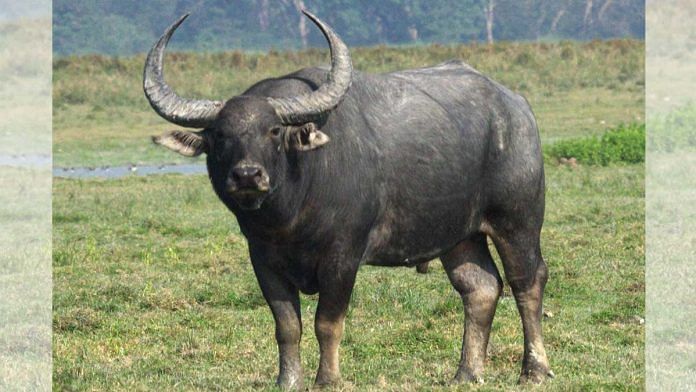Raipur: The Chhattisgarh government has launched efforts to revive the population of its state animal, the wild buffalo, which is on the verge of extinction.
Top government officials have told ThePrint that apart from planning artificial insemination, the state is getting wild buffaloes translocated from Assam.
The government is looking to double its wild buffalo population in the next two to three years. At present, there are just 10 of these animals left in the wild in Chhattisgarh.
Senior officials of the state forest department told ThePrint that four new female wild buffaloes will be translocated from the Manas National Park in Assam to Barnawapara Wildlife Sanctuary in Chhattisgarh for captive breeding. Their progeny will be then released into the wild.
Apart from this, the country’s and possibly the world’s first cloned wild buffalo, the female ‘Deepasha’, developed at the National Dairy Research Institute (NDRI) in Karnal, will be used for breeding to revive the population.
“Efforts to revive the population of wild buffalo, mainly through existing miniscule population, have failed to yield the desired results in the past 10 years but it will not happen now. If things go according to the plan it will lead to surprising results in the coming two-three years. State animal population may be up by double the existing number or more,” Arun Kumar Pandey, Additional Principal Chief Conservator of Forests, Wildlife, informed ThePrint.
Pandey told ThePrint that the state has adopted a three-pronged approach in its bid to increase the wild buffalo numbers.
“A three-pronged strategy is in place,” Pandey added. “The first is to allow natural breeding of the minuscule native wild buffalos. Second is the translocation of six forest buffaloes, five females and one male, from Manas National Park (MNP) in Assam for their captive breeding in Barnawapara Wildlife Sanctuary. The first pair of wild buffaloes already arrived in Chhattisgarh in April. By December, four more female wild buffaloes would be brought from Manas. These animals will be our parent stock and their progenies will be released into the wild”
The third, according to Pandey, is using Deepasha.
“The third big move is to use the ovum of the cloned female wild buffalo Deepasha for surrogacy breeding,” he said. “Deepasha is a clone of a native female wild buffalo ‘Asha’, kept in the forest of Gariaband district by the Forest Department. This will help in getting multiple calves simultaneously.”
Also read: Chhattisgarh set to have 8 new police camps in Naxal-hit districts amid ‘symbolic protests’
Deepasha to play vital role
According to the experts and state officials, common techniques of surrogacy in humans will be adopted for breeding the wild buffaloes. According to them, embryos would be injected into the wombs of domestic buffaloes by in vitro fertilisation (test tube baby).
“Usually a buffalo releases only one egg in a month. But here multiple eggs, around 5-10, will be produced and collected from cloned wild buffalo Deepasha through hormonal intervention and superovulation techniques,” said Dr Jasmeet Singh, a senior scientist at the state’s Wildlife Health and Forensic Centre.
“Thus 40-50 eggs could be collected within a few months. These eggs will be fertilised with semen collected from an identified male wild buffalo kept at the Udanti Sitanadi Tiger Reserve,” he added. “The fertilised eggs will be injected in the uterus of a common buffalo via Multiple Ovulation Embryo Transplant (MOET) technique. This will need several domestic buffalos as surrogates.”
Meanwhile, NGO Wildlife Trust of India (WTI) released a short video film on capturing and translocation of a wild buffalo couple from the MNP to Barnawapara.
According to the NGO, the film is meant to spread awareness on the conservation of the wild buffalo.
“The number of wild buffaloes in Chhattisgarh has been steadily decreasing due to poaching, anthropogenic pressure and lack of awareness for conservation,” said the trust’s central India head Dr Rajendra Mishra.
He also disputed the government’s figures on the number of wild buffaloes. “We did a survey in 2005 that revealed the presence of only six wild buffaloes in the wild,” he said.
Also read: ‘Congress govt has failed us’ — Bastar villagers demand release of jailed ‘innocent tribals’



